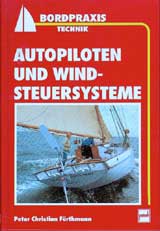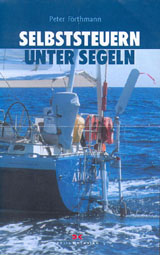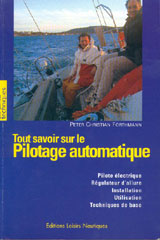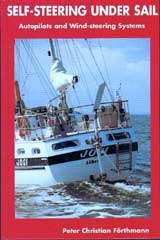 |
AUTOPILOTEN UND WINDSTEUERSYSTEMEby Peter Förthmann Pietsch Verlag Stuttgart |
|||||||
Régulateur d´Allurede Peter Förthmann |
Autopiloti e timoni a ventodi Peter Förthmann |
|||||||
Windvane or autopilot- it is one of the eternal questions of long-distance sailing. This practical guide brings clarity to the debate: it investigates the technologies behind all of today's common self-steering systems, explains which solutions are best suited to which type of boat with respect to size and construction, describes how to make the most of the various options on offer and examines the relative advantages and disadvantages of each. Which systems are good for racing and which for cruising? What are the limitations of each in terms of sea conditions and power consumption? |
||||||||
| Why is proper sail trim so important for good self-steering? Peter Förthmann answers these questions and more without resort to complicated diagrams and impenetrable technical speak. A comprehensive resource written from a wealth of personal experience, this book is full of clearly explained tips to help you choose the right self-steering solution and bring the best out of it in use. An overview of the market and a directory of almost all the self-steering systems available right around the world complete the picture. | ||||||||
 |
SELBSTSTEUERN UNTER SEGELNAutor: Peter Förthmann Verlag Delius Klasing 2005 Praxisberatung vom Profi ca. 178 Seiten, 125 teilweise vierfarbige Fotos, 27 Zeichnungen, Lieferbar ab 23.03.2005 |
|||||||
| In diesem Buch werden systematisch und leicht verständlich die Vor- und Nachteile aller Selbststeuersysteme mit dem Ziel dargestellt, sowohl dem Blauwassersegler als auch dem heimischen Freizeitsegler bei der Entscheidung für eines der Systeme zu helfen.
Nach einer kurzen Einführung in die Geschichte der Selbststeuerung werden ausführlich und praxisbezogen die beiden Arten der Selbststeuersysteme – der Autopilot und die unterschiedlichen Windsteuersysteme sowie die Synthese beider Systeme – vorgestellt und die jeweiligen Grenzen der Einsetzbarkeit aufgezeigt. |
Außerdem werden dem Leser im Hinblick auf Materialien, Selbstbau sowie Einbau bei den verschiedenen Schiffstypen Kriterien an die Hand gegeben, die ihm die Wahl für eines der Systeme erleichtern sollen.
Eine umfangreiche Marktübersicht der gegenwärtigen Hersteller ausgewählter Cockpit-Piloten und Windsteuersysteme und deren technische Daten runden das Buch ab. |
|||||||
 |
Tout savoir sur le Pilotage automatiquede Peter Förthmann Edition 2000 Pilote électrique |
|||||||
 |
SELFSTEERING UNDER SAILby Peter Förthmann Published 1998 by The book has been available again since December 2000. Contact
|
|||||||
Jimmy Cornell´s Foreword to the book:"For some strange reason, most cruising people profoundly dislike steering by hand. The prospect of spending hour after hour at the helmused to deter most people from long distance cruising. This is undoubtedly the main reason why, until relatively recently, the number of sailing boats venturing far afieldwas very small indeed. However, all that changed with the advent of automatic pilots specifically built for yachts plus the development of efficient wind operated self-steering devices. Suddenly, the chore of hand-steering was a thing of the past and long ocean passages could be a pleasure – even on yachts with the smallest of crews. Having made one circumnavigation of over 70.000 miles with an Aries and another of some 40.000 with a Hydrovane, I could not be accused of exaggerating if I state unreservedly that one of the most important pieces of equipment on any cruising yacht is a wind-operated self-steering gear. Unfortunately, and surprisingly, this view is not shared by many Cruising sailors. This is primarily because most of us have grown up with technology around us, we tend to take the push-button mentality with us to sea. Steering a given course is easy to achieve by setting a compass course and pushing a button on the autopilot, and, nowadays, this is what most sailors perfer to do. It is usually on the first morning with flat batteries that the love-affair with their favourite toy comes to an aprupt end. Having been forced to listen to countless heart-rendering stories on this very theme at the end of the ARC or similar trans-ocean rally, I managed to persuade Peter Förthmann to come to Las Palmas before the start of the ARC to talk to our participants about the pros and cons of self-steering. His talks and workshops became an instant success, not only becausde he knows this subject better than anyone else in the world, but also because he always speaks generically about both wind-operated self-steering gears and electronic autopilots. He never tried to sell his own products and, in this way, enjoyed the interest and confidence of his audience. I am therefore pleased, not only that he took my advice to write this long-overdue book, but also that he managed to do it so fairly and objectively by giving all his competitors an equal opportunity to make their products known. Alle existing systems are described in the following pages, allowing the reader to make up his own mind. Many sailors agree that Peter´s Windpilot is currently the best gear available. Being both the inventor and manufacturer of this ingenious device, Peter has indeed shown that his name should stand alongside those of his great precursors: Blondie Hasler, Marcel Gianoli, Nick Franklin. This book confirms Peter Förthmann´s standing as the world authority on wind-operated self-steering gears." |
George Day in BLUE WATER SAILING:"It's true: Big things come in small packages. Peter Christian Förthmann's unassuming little book on autopilots and wind-steering systems is a masterful reference work - eloquently presented, logically organized, wonderfully illustrated and easy to use. Anybody doing groundwork on a self-steering scheme owes it to himself to consult this source. |
|||||||
Andrew Bray in YACHTING WORLD 5/98:"Peter Förthmann's book, already published in German, is due for publication in English, by Adlard Coles, on 31 Luly. |
||||||||
OCEAN NAVIGATOR 12/98:"Because of the seemingly mystical reputation of these self-steering gadgets, a book dedicated entirely to their use and oerformance is well received. Choosing to purchase a windvane or autopilot is a big step - like committing yourself to something grand - because it imolies that the boat will soon be traveling long distances in one direction - in other words, crossing oceans. |
||||||||
The Book - A ChronologyJimmy Cornell started it! Peter Förthmann had been presenting his seminars on Self-steering under Sail in the UK and in the build-up to the ARC in Las Palmas, Gran Canaria for several years, but it was Jimmy Cornell who finally January 1999 October 1999 October 2000 The whole sobering tale revolves around the chapter of the book dealing with power generator and autopilot hybrid systems, in which a system known as Windhunter, which had been available for ten years or so in the UK and more recently in the USA as well, was described. The legal proceedings established the following facts: A "Test Report" on the Windhunter system published in Yachting World magazine in April 1995 was actually written by Windhunter president Sackville Currie, although the "Reprint" version of the report and the reproduction on the company's web site omitted to mention the author's name. The judge assigned to the case issued an order requiring the complainant to submit correspondence from dissatisfied customers and to name customers who had demanded their money back. The Windhunter system was continuously being modified and the user's manual was revised at least 58 times. The most recent version of the system, which appeared in April 2000, included features that the author had in effect recommended in the book at issue but that had been absent from the Windhunter of the time. "Self-Steering Under Sail"has been available again since December 2000. |
||||||||
Extract from Germany's Die Yacht (The Yacht) magazine No. 4/2001LEGAL VICTORY Peter Förthmann, owner of Hamburg-based Windpilot, published an interesting book about autopilots and windvane steering systems in Germany in 1996 (Pietsch Verlag). The English version of the book was picked up by Adlard Coles Nautical in London and published in 1998. The book was enlarged for the English-language market and among the content added was a fairly detailed look at the Windhunter. This hybrid generator/autopilot system was developed in the early 1990s and became quite well known thanks to a favourable 1995 write-up in Yachting World. Publishers Adlard Coles Nautical reached an expensive settlement with Curran after a year of the proceedings and withdrew the book from the market. Supported by more and more testimonies from dissatisfied Windhunter customers, Förthmann on the other hand decided to stick to his guns and eventually prevailed. The judge in the case ordered Curran, the complainant, to meet all the costs of both parties and to hand the damage settlement paid by the publisher straight back to the author. The Windhunter system has subsequently been withdrawn from the market. |
||||||||
